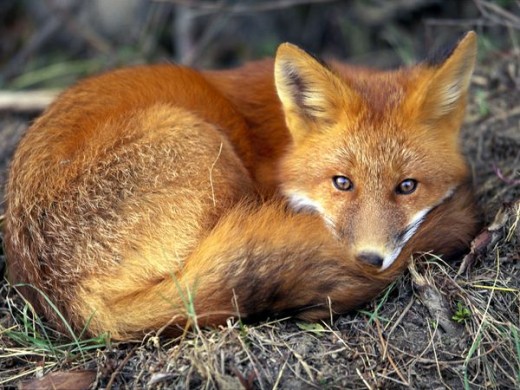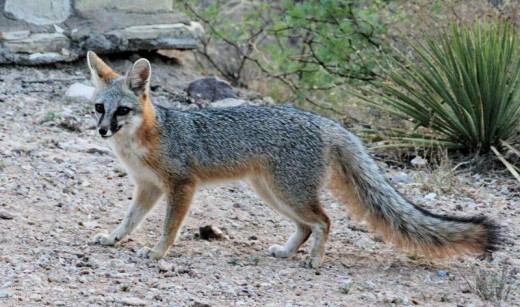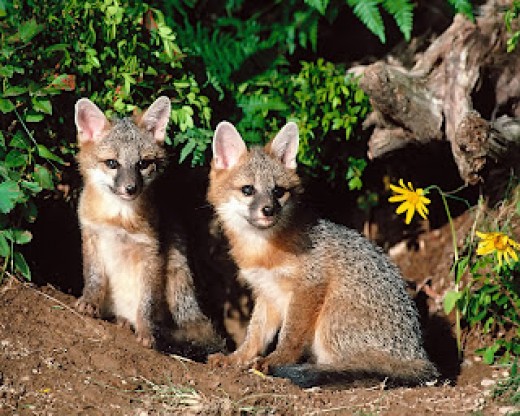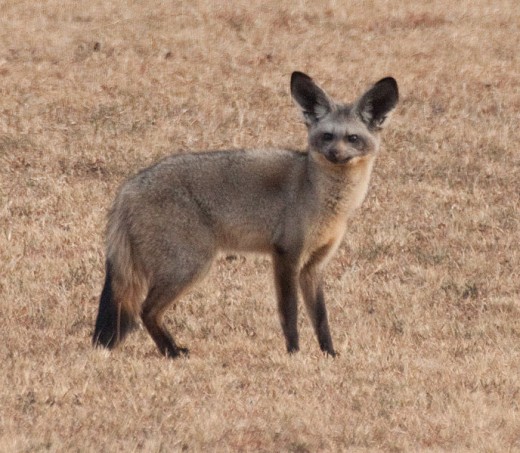When you get into the world of an entire family
such as that of the Canidae , you tend to find that when you get into
the smaller species, the examples of such become a lot less dog like,
and very different from what you had in mind due to your frame of
reference. In fact, foxes are not canines of the classification of
wolves, coyotes, and dogs at all, but do have their own classification
or tribe, and the tribe of the family in which the foxes fall is that of the Vulpini.
Before I go further with anything here I should take a moment to explain just what in the world the difference could be between a gray fox and a grey fox, there is absolutely no difference at all. I just keep my browsers set to The Queen's English, and I do this because it probably fools people into thinking that I'm much smarter than I actually am. A grey fox, is indeed a gray fox.
Though these grey foxes can be found from Southern Canada all the way south into South America, the only ones that I've ever seen were at the Caldwell Zoo in Tyler, Texas. I'd have had a picture to share, but Mr. Gray Fox of the Caldwell Zoo...shared little of the kind of interest in posing for the camera as did the super fine African leopard that I admired so much. Had I taken a picture of the fox, I'd only have some pointed fuzzy ears to show you. I think he or she was protesting the rations or the lack of privacy.
Before I go further with anything here I should take a moment to explain just what in the world the difference could be between a gray fox and a grey fox, there is absolutely no difference at all. I just keep my browsers set to The Queen's English, and I do this because it probably fools people into thinking that I'm much smarter than I actually am. A grey fox, is indeed a gray fox.
Though these grey foxes can be found from Southern Canada all the way south into South America, the only ones that I've ever seen were at the Caldwell Zoo in Tyler, Texas. I'd have had a picture to share, but Mr. Gray Fox of the Caldwell Zoo...shared little of the kind of interest in posing for the camera as did the super fine African leopard that I admired so much. Had I taken a picture of the fox, I'd only have some pointed fuzzy ears to show you. I think he or she was protesting the rations or the lack of privacy.
Urocyon cinereoargenteus - The Grey Fox

Biological Traits, and Climbing Trees!
I
don't know about you, but the above photograph of the grey fox looks to
me like something some mad scientist created by fusing some kind of cat
and a coyote's DNA. If you aren't into the idea of God, then you must
surely recognize that there are many observable laws guiding the
universe, and the way things happen in nature. Then, beyond the
observable laws that a materialist philosopher, and the most idiotic of
the atheist that I know of, Richard Dawkins, even surely agrees
to exists - there is chaos theory, and the quantum theory that blows all
the other notions to bits. To me, these laws, and the further laws that
obliterate them, those are just some of the distinctions of what makes
God omniscient and so indescribable that he can neither be proved nor
disproved, and is ever on the minds of every last one of us, in praise,
wonder, or opposition and derision.
Nevertheless, the gray fox can climb trees. I'll state that again in case you missed it, this little coyote looking thing can climb a tree like a cat. Biology and the natural world are filled with such wonders and pleasure that nobody can even begin to grasp the whole of it, even those who devote their entire lives to it - and it is just a small part of a seemingly insignificant planet in an infinite and expanding multiverse.
Why do gray foxes climb trees? Well, they climb trees to get away from things like coyotes and domestic dogs. They also sometimes feed on things in trees, but this is primarily vegetation, as gray foxes aren't so nimble that they can hunt in trees. Getting out of a climbed tree, just like for anything else, is a bit more of a troublesome issue than is climbing the tree in the first place. Gray foxes will either descend slowly limb by limb, or just scoot backwards down the trunk the way that a domestic cat would do. Please don't call the fire department or the police should you see a gray fox that appears to be stuck up one of your trees. I'd imagine you'd get a reputation with the public servants as a nuisance yourself for such shenanigans, and besides, you should be thinking instead of finding your good digital camera, so that you can email me a picture for updating this hubpage instead.
Nevertheless, the gray fox can climb trees. I'll state that again in case you missed it, this little coyote looking thing can climb a tree like a cat. Biology and the natural world are filled with such wonders and pleasure that nobody can even begin to grasp the whole of it, even those who devote their entire lives to it - and it is just a small part of a seemingly insignificant planet in an infinite and expanding multiverse.
Why do gray foxes climb trees? Well, they climb trees to get away from things like coyotes and domestic dogs. They also sometimes feed on things in trees, but this is primarily vegetation, as gray foxes aren't so nimble that they can hunt in trees. Getting out of a climbed tree, just like for anything else, is a bit more of a troublesome issue than is climbing the tree in the first place. Gray foxes will either descend slowly limb by limb, or just scoot backwards down the trunk the way that a domestic cat would do. Please don't call the fire department or the police should you see a gray fox that appears to be stuck up one of your trees. I'd imagine you'd get a reputation with the public servants as a nuisance yourself for such shenanigans, and besides, you should be thinking instead of finding your good digital camera, so that you can email me a picture for updating this hubpage instead.
The Raccoon Dog, The Only Other Canid Able To Climb Trees

A Red Fox

The Smart Gray Fox
- The Smart Gray Fox
A very well written and nice hub about gray foxes by Hubpages' own laurentmikhail
My Gray Fox Story - The One I Never Saw
I've
got no grey or gray fox story to tell here from my cannon of human
hallucinations, misinterpreted experiences, and over and under blown
sense's of self that are sometimes referred to as my life; so I'll give
you, dearest reader, a brief interlude containing what I do have.
I've got a story about a gray fox that I never saw, but was really keen to see, having never and still not laid eyes upon one in the wild. Heck, for all that I know the one's I've seen in zoos are just cats or coyotes raised on Monsanto GMO and hormone affected foods. I've no proof otherwise - just a lot of conjecture concerning these so called gray or grey foxes.
There's an elementary school Southeast of Dallas, but still a part of the Dallas Public School District called Kleberg Elementary School, and it's in a semi wooded area, has lots of land belonging to the school that isn't being used, and was supposedly a home in the early mornings for visible gray foxes, but the ones that were present the several and recurring mornings of the years when I worked for the school district where foxes are too smart to play - were of the invisible gray fox variety, and I could find you some pictures of the invisible gray foxes if you'd like - I'd not have anyone think I told tales that one wouldn't tell in church, you know.
I've got a story about a gray fox that I never saw, but was really keen to see, having never and still not laid eyes upon one in the wild. Heck, for all that I know the one's I've seen in zoos are just cats or coyotes raised on Monsanto GMO and hormone affected foods. I've no proof otherwise - just a lot of conjecture concerning these so called gray or grey foxes.
There's an elementary school Southeast of Dallas, but still a part of the Dallas Public School District called Kleberg Elementary School, and it's in a semi wooded area, has lots of land belonging to the school that isn't being used, and was supposedly a home in the early mornings for visible gray foxes, but the ones that were present the several and recurring mornings of the years when I worked for the school district where foxes are too smart to play - were of the invisible gray fox variety, and I could find you some pictures of the invisible gray foxes if you'd like - I'd not have anyone think I told tales that one wouldn't tell in church, you know.
A Gray Fox In Utah - UROCYON CINEREOARGENTEUS

The Unknown Fox Cousins Of Red Foxes
- The Unknown Fox Cousins Of Red Foxes
Red foxes are well known to most people, especially here in the United States, even if they aren't an animal we see everyday. What isn't thought about much, is the fact that they are wild relatives of the dog. Among the wild relatives of the dog, the
What Do Gray Foxes Eat?
Gray
foxes are omnivorous critters that are solitary hunters. The gray foxes
of the world don't hunt in packs like wolves or coyotes, they are more
cat like in their hunting habits, and hunt totally alone as do bobcats,
jaguars, and mountain lions. Basically, when it comes to gray fox
cuisine, what we're looking at here is a creature that loves to eat
those rascally rabbits more than anything else at all. Eastern
cottontail rabbits, whether their name happens to be Peter cottontail, or not, are just fine for gray foxes. Rabbits named Jack,
or jack rabbits taste just fine to the grey foxes, as do brush rabbits
too.That's not the extent of it, however, these foxes also enjoy eating
birds, voles, shrews, fruits, and sometimes vegetation too. In fact,
gray foxes are more fond of vegetation than are red foxes.
Gray Fox Kits

Monogamous Gray Foxes, and Gray Fox Kits
Gray
foxes are monogamous as are gray wolves. If you don't know, then let me
help you out here, gray foxes mate for life, and they don't behave like
Newt Gingrich in any way, shape, or fashion. They're serious about
their reproduction and mating, and they make no bones about it, weird
puns intended.
Gray foxes are seasonal specific breeders, but the months in which they breed are varied due to geography and the climate involved in their locations. In states like Michigan foxes breed later in the year than they will do in Texas, and other warmer states, where they tend to breed a month or so earlier in the late Winter or early Spring. Around fifty three days after breeding, a mother gray fox will give birth to between one and seven itty bitty gray fox kits, three months later the kits are basically autonomous, but remain with their family until autumn, then they disperse out into the world on their own.
There is very little in the way of sexual dimorphism in gray foxes. What does that mean? It's really simple, it's just fancy words - sexual dimorphism describes the difference in sizes of adults of a species in regards to the males and females. In gray foxes with their very little sexual dimorphism - all that is meant is that the adult males and adult females are pretty much the same size and weight.
Gray foxes are seasonal specific breeders, but the months in which they breed are varied due to geography and the climate involved in their locations. In states like Michigan foxes breed later in the year than they will do in Texas, and other warmer states, where they tend to breed a month or so earlier in the late Winter or early Spring. Around fifty three days after breeding, a mother gray fox will give birth to between one and seven itty bitty gray fox kits, three months later the kits are basically autonomous, but remain with their family until autumn, then they disperse out into the world on their own.
There is very little in the way of sexual dimorphism in gray foxes. What does that mean? It's really simple, it's just fancy words - sexual dimorphism describes the difference in sizes of adults of a species in regards to the males and females. In gray foxes with their very little sexual dimorphism - all that is meant is that the adult males and adult females are pretty much the same size and weight.
Wikipedia's Map For the California Channel Island Foxes, The Unique Species, and Distribution.

Gray Foxes, Red Foxes, and The California Channel Island Foxes.
Now
we all know or should know that various and sundry animals sometimes
have colourations that are contrary to their names. Red wolves look sort
of grey sometimes, and black bears can be very brown, so forth and so
on. Mostly though, red foxes are very red and gray foxes are very gray
(or grey). The distinguishing characteristics are that gray foxes pretty
much always have a very black tipped tail, and red foxes always have
some very black "sox" or colouration on their legs, and generally it's
all four of them.
There are some other distinguishing features of gray foxes, but those have to do with things that you'd not see on a living gray fox, but rather, are distinguishing characteristics of grey foxes in their bones. For that reason, I'm not going to bother with that here, as my target audience is definitely not a biologist. I'd not wish to be put to peer review for my articles that are meant to be informing and entertaining for a much wider audience.
What is totally unavoidable for persons discussing biology on the web is the subject of evolution. I tend to just "go with it," but I do that more to avoid controversy than anything else, and I always love to show how there are more often than not - vast amounts of controversy within evolutionary biology, and I do mean between biologist that are total evolutionists.
Despite all of that, on the subject of foxes, and the independent yet unavoidable subject of evolution - landing squarely on the side of evolutionary biologists everywhere as seemingly proof of their claims is the six species of California Channel Island Foxes, remote and strange critters that have definitely seemed to have evolved in some very strange ways that are quite different from their cousins, the gray foxes of the Americas. The dwarfish Channel Island Foxes are absolutely fascinating, and deserve a lot of attention totally separate from what I'll provide here, but three cheers for the naturalist of California for the tremendous job they've done towards protecting these VERY fragile creatures from extinction.
So far as one last notion concerning evolutionary biology, and despite the fact that I absolutely loath Richard Dawkins in more ways than I could even conceive of consciously, have a look below at the African Bat Eared Fox, the other closest relative to the gray foxes besides the raccoon dog. Alas, the African bat eared fox can not climb trees, like another person I don't much care for once sang, .you can't always get what you want, but if you try some times, you might find, you get what you need.
There are some other distinguishing features of gray foxes, but those have to do with things that you'd not see on a living gray fox, but rather, are distinguishing characteristics of grey foxes in their bones. For that reason, I'm not going to bother with that here, as my target audience is definitely not a biologist. I'd not wish to be put to peer review for my articles that are meant to be informing and entertaining for a much wider audience.
What is totally unavoidable for persons discussing biology on the web is the subject of evolution. I tend to just "go with it," but I do that more to avoid controversy than anything else, and I always love to show how there are more often than not - vast amounts of controversy within evolutionary biology, and I do mean between biologist that are total evolutionists.
Despite all of that, on the subject of foxes, and the independent yet unavoidable subject of evolution - landing squarely on the side of evolutionary biologists everywhere as seemingly proof of their claims is the six species of California Channel Island Foxes, remote and strange critters that have definitely seemed to have evolved in some very strange ways that are quite different from their cousins, the gray foxes of the Americas. The dwarfish Channel Island Foxes are absolutely fascinating, and deserve a lot of attention totally separate from what I'll provide here, but three cheers for the naturalist of California for the tremendous job they've done towards protecting these VERY fragile creatures from extinction.
So far as one last notion concerning evolutionary biology, and despite the fact that I absolutely loath Richard Dawkins in more ways than I could even conceive of consciously, have a look below at the African Bat Eared Fox, the other closest relative to the gray foxes besides the raccoon dog. Alas, the African bat eared fox can not climb trees, like another person I don't much care for once sang, .you can't always get what you want, but if you try some times, you might find, you get what you need.
The Bat Eared Fox Of Kenya, a Relative Of The Gray Fox

0 comments:
Post a Comment